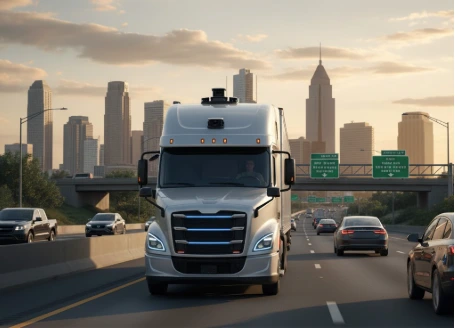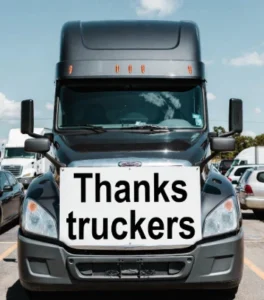The recent federal probe into Tesla’s vehicles reportedly running red lights has reignited a key question: How safe are autonomous driving systems for highway freight transport? In a world where “smart fleets” promise efficiency and savings, safety is once again taking center stage.
The U.S. National Highway Traffic Safety Administration (NHTSA) announced a new investigation into roughly 2.88 million Tesla vehicles equipped with the company’s Full Self-Driving (FSD) software. The inquiry follows more than 50 reports of traffic violations, including at least six crashes involving vehicles entering intersections against red lights.
The complaints describe several serious issues:
Failing to stop completely at red lights
Ignoring traffic signals entirely
Making unsafe lane changes into oncoming traffic
Failing to reliably recognize road signs
Tesla maintains that FSD is not a fully autonomous system — drivers must supervise and remain ready to intervene at any moment. Similar concerns have previously surrounded Tesla’s Autopilot, a Level 2 advanced driver-assistance system involved in multiple fatal crashes linked to software faults or driver inattention. Critics have also accused Tesla of delayed reporting of safety incidents, a potential breach of U.S. regulatory requirements.

Could the Same Happen with Autonomous Freight Trucks?
To evaluate that risk, it’s useful to compare the operational and technical challenges of Tesla’s passenger vehicles with those of future self-driving freight trucks.
1. Operational Complexity
Freight trucks operate on diverse routes — highways, rural roads, steep grades, and complex intersections. Their sensors must interpret large overhead signs, long-distance signals, intense headlights, and adverse weather. Each factor increases the chance of perception errors.
2. Vehicle Size and Weight
A truck’s massive inertia means that a late braking response or small miscalculation can have far more catastrophic results. Heavier loads amplify the distance and force needed to stop safely.
3. Sensor Design and Redundancy
True safety requires multiple redundant sensors (LIDAR, radar, cameras, ultrasonic) with internal diagnostics and “safe degradation” modes if a component fails. Cross-verification between sensors helps reduce the likelihood of a single-point failure.
4. Higher Safety Standards
Autonomous freight vehicles will likely face stricter certification and testing requirements than consumer cars. Third-party audits, transparent validation protocols, and ongoing performance reporting are essential before granting full commercial operation.
5. Human Oversight and Remote Supervision
Many pilot programs envision remote operators or onboard supervisors to handle critical moments. Transitions between autonomous and manual control must be seamless and predictable.
Realistic Risks for the Freight Industry
Even with advanced systems, it’s not impossible for an autonomous truck to misread a red light or ignore a signal due to sensor failure, data-fusion errors, or flawed prediction models. The more robust the system design — with overlapping sensors and anomaly detection — the lower the risk, but never zero.
Key risks include:
Cargo loss or damage from high-speed collisions
Legal liability disputes among fleet owners, system developers, and insurers
Public trust erosion if serious incidents occur, slowing regulatory approval
Supply chain disruptions from delayed or unreliable freight operations
Are Autonomous Freight Trucks Safe Today?
Not yet — at least not with the current generation of technology. Today’s systems remain in an experimental or early-commercial phase, and recent Tesla incidents highlight the urgency of stronger oversight.
Before autonomous freight trucks can safely operate at scale, the industry must ensure:
Public testing and validation protocols
Independent safety audits
Clear accountability for system failures
Transparency about system limitations and human intervention needs
Built-in redundancy and safe fallback modes
Autonomous trucking may indeed represent the future of logistics — but only if that future is built on uncompromising safety, rigorous regulation, and full public confidence.

The strangest Black Friday purchases: from funny to nothing
Fueled by the adrenaline of the moment and the excitement of scoring big discounts, many shoppers have ended up buying unusual items during Black Friday.

Young drivers wanted, older drivers needed: the industry’s biggest dilemma
The road transportation industry remains at a crossroads in its efforts to recruit young drivers, but the workforce keeps aging and seeking retirement. The road

Thanksgiving, Black Friday and the Long Weekend: America Moves Because Trucks Never Stop
Thanksgiving, Black Friday and the Long Weekend: America Moves Because Trucks Never Stop

Thankful for the Drivers Who Keep America Moving This Thanksgiving
Thankful for the Drivers Who Keep America Moving: The Invisible Work Behind One of the Busiest Thanksgiving Seasons

Preparing for Thanksgiving travel: best and worst times to travel
Whether you are a truck driver, a traveler, or simply someone who needs to move around during these days, we share essential information to help

Cargo theft spikes during Thanksgiving: how to stay safe
Every year during Thanksgiving, cargo theft poses a serious threat to the trucking industry, and this year will be no exception. Every year during Thanksgiving,
